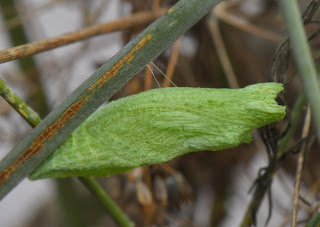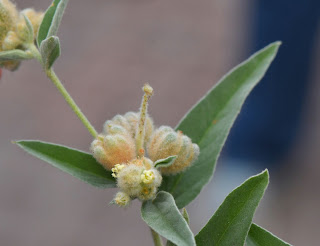Today's Ramble was led by Linda Chafin.
Here's the link
to Don's Facebook album for today's Ramble. (All the photos in this post are
compliments of Don, unless otherwise credited.)
Today's post was written by Linda Chafin (plants) and Dale
Hoyt (animals).
Today’s Focus:
25 Ramblers met today.
Show and
Tell:
Berkeley brought some Eastern Black Swallowtail chrysalises
that developed from caterpillars feeding on fennel.
Two of the chrysalises, attached
to the fennel stems, were green. The
others, attached along the upper edge of the cage, were a mottled brown color.
It is tempting to conclude that the color of the chrysalis matches its
environment, but mismatches are common (green chrysalis among dead weeds, brown among leafy vegetation).  | |
| Eastern Black Swallowtail chrysalis, green form. The silk belt that suspends it can be seen around mid-body. (click to enlarge) |
Swallowtail chrysalises are unusual in
that they do not hang downward from the end of the abdomen. Instead they lean against a silken “belt” they spin themself. It is anchored to the pupation site they lean from.
 |
| Woolly Croton (click to enlarge) |
Catherine brought a sprig of Woolly Croton, which grows
abundantly in her yard and is loved by her chickens. Unlike the native Tooth-leaved
Croton we saw in the Nash Prairie last week, this species is not native to the
southeast, though its exact native distribution is not known.
Today's reading:
Sue read the first two paragraphs of an article by Holly
Haworth that appeared in the New York Times August 20, 2019. The whole
article is worth reading, but the first two paragraphs are presented here
just to whet your appetite:
Insects had the earth about
400 million years before we did. For centuries stacked on centuries, what a
great whirling, stirring buzz it must have been: the pulsing thrums of cicadas,
tiny whine of mosquitoes and droning hum of bees. Though it has certainly
quieted down a bit during the past few hundred years, every night the
persistent cricket presses on. Stubborn stridulating cricket! Chirp, chirp,
chirp, as if nothing has changed for millenniums.
A field cricket lazes all day
in its burrow. Then, in the evening, just when you’re ready to relax, out comes
the well-rested cricket with its own built-in instrument, ready to make a
ruckus. The instrument is in two parts: on the top of the lower wing a rough
blade called a scraper; on the underside of the upper wing a row of bumps, like
teeth. Scraper saws teeth. And scraper saws teeth. And scraper saws teeth.
Today's route:
From the plaza through the Children’s Garden to the White Trail Spur to the
powerline RoW. Then down the RoW to the River and turn right and walked
upstream on the White Trail until time to return. We retraced out path and
enjoyed beverages and conversation at Café Botanica.
LIST OF
OBSERVATIONS:
White
Trail, woods to ROW:
The end of August and early September bring an
explosion of wildflowers in the Aster family, often called the Composite
Family. This drawing illustrates the “composite” nature of their flower heads: a whorl of petal-like ray flowers surrounding
a disk- or cone-shaped structure holding lots of small disk flowers.
 |
| Structure of a composite flower head. |
 | |
| White Crownbeard is
having a bumper year–the entire open slope above the floodplain is white with
their flower heads. (click to enlarge) |
 |
| Rough Sunflower also has dark anthers emerging from the opened disk flowers. In the very center, you can see immature disk flowers still in bud.(click to enlarge) |
 |
| Tall Goldenrod is a very aggressive, “thuggish” native, but it forms a beautiful mass of gold throughout the right-of-way, especially in contrast to Ironweed flowers.(click to enlarge) |
 |
| Tall Ironweed (click to enlarge) |
 |
| Late Boneset (aka Late-flowering Thoroughwort), another ray-less member of the Composite family.(click to enlarge) |
RoW, to river:
 |
| Sheetweb spider web (click to enlarge) |
Sheetweb spiders (family Linyphiidae) make bowl- or dome-shaped webs that are filled with a tangle of non-sticky silk threads. The spider hangs on the underside of the web and when an insect blunders into the web it gets entangled in mesh of threads. The spider bites its prey from below and pulls it through for eating.
 |
| Bowl and Doily spider on the web, between the bowl and doily. (click to enlarge) |
The Bowl and Doily spider has two connected webs, the lower one flatter and the upper one bowl-shaped. The spider lives between the two, hanging upside down on the bottom of the bowl. Prey entangled in the bowl are devoured in the living space between the two webs.
 |
| Dodder is a native flowering plant, but is wholly parasitic on its green, photosynthesizing host plants.(click to enlarge) |
 |
| Gulf Fritillary butterfly. The adults are here now, look for caterpillars in the coming weeks. (click to enlarge) |
White Trail, west of RoW:
 |
Sand Bean flowers
are usually pink but occasionally a creamy yellow. Those long, green projections are the bean pods, like skinny green beens.
(click to enlarge)
|
 |
Here ants are seen nectaring
on the yellow Sand Bean flowers.(click to enlarge)
|
 |
Air Potato, or Cinnamon Vine, or Chinese Yam. (click to enlarge)
|
Cinnamon Vine is an invasive species native to China. It
produces aerial tubers that fall off, form roots, and give rise to a new plant.
It also produces large, underground tubers that are eaten as food and medicine
in China.
 |
Stinging Wood-nettle flowers and stem with urticating hairs. (click to enlarge)
|
Stinging Wood-nettle,
native to eastern and central North America, grows throughout the floodplain at
the Garden. Its stinging hairs are found all along the stems and leaves and even
in the inflorescence. The hairs are brittle and hollow, and break off when
touched. They then release a fluid that contains a witch’s brew of irritating
compounds that smart mammals learn to avoid. Apparently, invertebrates aren’t harmed
by the compounds–maybe they are protected by their exoskeletons? Note that Stinging
Wood-nettles have alternate leaves, which separates them from a number of other
stinging nettle species. We may not love the stinging, but we gotta love the
beautiful Red Admiral, which uses nettles as a larval host plant.
 |
Jackson Briar tendrils that reverse their coiling direction.(click to enlarge)
|
Jackson Briar, a
high-climbing, nearly spineless, member of the Smilax genus, has stout tendrils. Notice in Don’s photo that the
tendril twists clockwise for about half its length, then changes to counter-clockwise
for the other half. This odd growth pattern, which occurs in many
tendril-bearing species across the plant world, mystified scientists (including
Darwin!) for many years. Recently, a group of engineers, physicists, and
biologists figured it out! The mathematically minded can read about it
here: https://science.sciencemag.org/content/337/6098/1087.full
 |
Cat-brier, unlike Jackson Briar, is covered with prickles.(click to enlarge)
|
Cat-brier is
another Smilax, but unlike Jackson
Briar it is covered with prickles, even on the leaves. During the ramble, I
called this Smilax auriculata and
pointed out the eared leaf bases, but that’s wrong–it’s actually Smilax bona-nox. The species name means
“good night” – maybe it was used a sleeping potion? There was no info about
this on the internet so I have no idea!
 |
| Sweet Autumn Clematis (click to enlarge) |
 |
| Virgin's Bower Clematis (click to enlarge) |
Sweet Autumn
Clematis and Virgin’s Bower Clematis are growing near each other along the
White Trail, giving us an opportunity to compare these look-alike species.
Sweet Autumn, an invasive exotic vine, has 3-7, entire-edged leaflets per leaf;
Virgin’s Bower has 3 toothed leaflets per leaf. The stamens of Sweet Autumn are
pure white; Virgin’s Bower stamens are greenish-yellow at the base. Sweet
Autumn flowers are fragrant; Virgin’s Bower not so much. You will find these
two common names used interchangeably for the different species, so caveat
emptor!
 |
Coralbeads
or Carolina Moonseed. Squish the fruit to reveal the coiled seed that resembles
a crescent moon.(click to enlarge)
|
 |
| Virginia Dayflower, in the same family as spiderworts, has three blue petals. A common exotic species, Common Dayflower, has two blue petals and one white petal.(click to enlarge) |
 |
| Spotted Jewelweed, a favorite of foraging hummingbirds.(click to enlarge) |
 |
| Climbing
Hempvine, one of the very few vines in the Aster family. It is not related to
Hemp/Marijuana.(click to enlarge)
|
 |
The "Mystery Insect" is a kind of Planthopper - Paramysidia mississippiensis.(click to enlarge)
|
A “mystery Insect”
gave us fits trying to identify it. At first glance they looked like small
moths, but didn’t behave like them. When approached closely they jumped into
flight. I could swear that I heard a tiny “snap” as each insect jumped off the
grass blade and flew away. With a hand lens I managed to see them well enough
to figure out that they were related to aphids or planthoppers. Don submitted
his photograph to bugguide.net and got this answer: the Mystery Insect is a
kind of Planthopper with no common name, Paramysidia mississippiensis. Very
little seems to be known about it, but what there is can be found at this University of Delaware website. The nymphal stages are reported to feed on
woody fungi and this species has been found on Sabal Palmetto and Maples.
 |
Cone Headed
Katydid (click to enlarge)
|
Cone Headed Katydids take their name for the pointy head. The males produce a sound by rubbing their two forewings together, like a cricket. Each time the wings make a single rub a sound is produced. In crickets this sound is a "chirp." But the coneheads rub their wings together much faster than crickets do and they don't pause. The result is a continuous sound of very high frequency. Older human ears may no longer be able to hear it, but I remember how loud it was when I was a child with a flashlight, searching for a high-pitched sound source in my backyard.
ROW, near road:
 |
Creeping Cucumber’s tiny yellow
flowers will soon produce small, melon-like fruits.(click to enlarge)
|
Case-bearing leaf beetle (no common
name) Cryptocephalus badius(click to enlarge)
SUMMARY OF OBSERVED SPECIES:
Yellow Crownbeard
|
Verbesina occidentalis
|
White Crownbeard
|
Verbesina virginica
|
Common Wingstem
|
Verbesina alternifolia
|
Rough Sunflower
|
Helianthus strumosus
|
Tall Thistle
|
Cirsium altissimum
|
Tall Goldenrod
|
Solidago altissima
|
Sheetweb Spider (web)
|
Araneae: Linyphiidae
|
Dotted Smartweed
|
Polygonum punctatum
(= Persicaria punctate) |
Tall Ironweed
|
Vernonia gigantea
|
Bowl and Doily Spider and web
|
Frontinella pyramitela
|
Dodder
|
Cuscuta sp.
|
Gulf Fritillary Butterfly
|
Argraulis vanillae
|
Sand Bean
|
Strophostyles umbellata
|
Black Ant
|
Hymenoptera: Formicidae
|
Late Flowering Thoroughwort
|
Eupatorium serotinum
|
Stinging Wood Nettle
|
Laportea canadensis
|
Red Mulberry
|
Morus rubra
|
Cinnamon Vine
|
Discorea polystachya
|
Jackson-Briar
|
Smilax smalii
|
Cat-brier
|
Smilax bona-nox
|
Pennsylvania Smartweed
|
Polygonum pensylvanicum syn. Persicaria
pensylvanicum
|
Climbing Buckwheat
|
Fallopia scandens
|
Climbing Hempvine
|
Mikania scandens
|
Mystery insect
|
Paramysidia mississippiensis
|
Sweet Autumn Clematis
|
Clematis terniflora
|
Virgin’s Bower Clematis
|
Clematis virginiana
|
Coralbeads
|
Cocculus carolinus
|
Virginia Dayflower
|
Commelina virginica
|
Spotted Jewelweed
|
Impatiens capensis
|
Milkvine
|
Matelea sp. or Gonolobus sp.
|
Cone Headed Katydid
|
Orthoptera: Tettigoniidae1: Copiphorinae2
|
Creeping Cucumber
|
Melothria pendula
|
Case-bearing leaf beetle (no common name)
|
Cryptocephalus badius
|
1 family name ends in - idae
2 subfamily name ends in -inae |





